Nature
Cure Clinic and Hospital
15 Oldbury Place, W1U 5PQ
Medical
dates:
Medical
character:
Specialist (Out-Patients only)
Early in 1928 the artist and
animal rights campaigner Nina
Hosali was asked by some humanitarians to
establish a nature cure clinic for those of limited means who could not
afford the fees of private practitioners.
The Nature Cure Clinic opened in October 1928 in an apartment above Druce's Depository at No. 41 Baker Street. Its founding principles were based on anti-vivisection, natural healing and vegetarianism, and free out-patient treatment was provided by medically qualified practitioners who believed in nature cure - among whom were Dr Bertrand Peter Allinson (son of Dr Thomas Richard Allinson, who gave his name to the famous wholemeal loaf), Major Reginald F.E. Austin (1866-1939) and Dr Henry Valentine Knaggs (1858-1954). They were supported by therapists who provided massage and osteopathy, etc. However, difficulties arose in the early years as this latter group was unhappy to accept the Clinic's policy of supervision by medically qualified doctors, while the General Medical Council, on the other hand, pressured qualified medical men not to work with unqualified practitioners.
By 1937 the Clinic had an honorary staff of 8 regular medical practitioners assisted by 10 others (osteopaths, etc.). The use of drugs was discouraged, except for homoeopathic, biochemical and herbal therapies.
In March 1938 a Hospital for in-patients was opened in Putney. However, at the outbreak of WW2 in 1939, this building was requisitioned by the Government.
In 1940 the Out-Patient building was destroyed by bombs, but the Clinic was quickly re-established in Dorset Square, in the house of Dr Bertrand Allinson (the Clinic lost only 30 working days during this episode).
At the end of the war in 1945, the Clinic moved to new premises at No. 13 Oldbury Place. The staff gave their services voluntarily and once again,
various therapies were offered, now expanded to include dieting (fasting and a raw vegetarian diet were often prescribed), homoeopathy, herbal treatment, manipulation (osteopathy, chiropractic), massage, remedial exercises, physiotherapy, reflexology, chiropody, acupuncture, eye treatment, hydropathy and relaxation techniques. It also provided gynaecological and obstetric advice, and promoted relaxation, fresh air, dancing and exercise. Drug therapy and surgical measures were avoided as far as possible.
There was little hope of the Hospital in Putney re-opening for in-patients, mainly due to financial restraints and the lack of the right staff to run it.
In 1948 the Clinic was not included in the NHS. The Ministry of Health had not considered it, but would have done so if the Clinic's management committee had desired it. However, with no guarantee of freedom of clinical action, the committee decided the Clinic should remain independent of the NHS.
During the 1950s arrangements were made with the Royal London Homoeopathic Hospital for the Clinic's patients to be sent there for X-ray examination.
On 21st March 1958 the Clinic, which until then had been an unincorporated body of individuals, became a corporation. Each appointed member of the staff was required to sign a declaration to upload the Clinic's humanitarian principles of natural therapies and to promote vegetarianism. No animal products were to be used in the preparation of vaccines, etc. A few of the doctors were, in fact, Vegan.
After 29 years the premises had become very cramped and the Clinic moved to a new freehold building, purpose-built for it, next door at No. 15 Oldbury Place. The Clinic was officially opened by the politician Fenner Brockway on 2nd June 1976, at a ceremony held at the Polytechnic of Central London.
In 1977 the building was extended when a second floor with four rooms was added, dedicated to Dr Bertrand Allinson. The Clinic then had a total of seven consulting rooms.
In January 1987 Nina Hosali, the founder of the Clinic, died.
The Clinic continued to provide affordable treatments for the next 20 years, but as alternative medicines became more available on the NHS, in 2007 it was decided to merge with the Institute for Complementary Medicine to form the Institute for Complementary and Natural Medicine.
The Nature Cure Clinic opened in October 1928 in an apartment above Druce's Depository at No. 41 Baker Street. Its founding principles were based on anti-vivisection, natural healing and vegetarianism, and free out-patient treatment was provided by medically qualified practitioners who believed in nature cure - among whom were Dr Bertrand Peter Allinson (son of Dr Thomas Richard Allinson, who gave his name to the famous wholemeal loaf), Major Reginald F.E. Austin (1866-1939) and Dr Henry Valentine Knaggs (1858-1954). They were supported by therapists who provided massage and osteopathy, etc. However, difficulties arose in the early years as this latter group was unhappy to accept the Clinic's policy of supervision by medically qualified doctors, while the General Medical Council, on the other hand, pressured qualified medical men not to work with unqualified practitioners.
By 1937 the Clinic had an honorary staff of 8 regular medical practitioners assisted by 10 others (osteopaths, etc.). The use of drugs was discouraged, except for homoeopathic, biochemical and herbal therapies.
In March 1938 a Hospital for in-patients was opened in Putney. However, at the outbreak of WW2 in 1939, this building was requisitioned by the Government.
In 1940 the Out-Patient building was destroyed by bombs, but the Clinic was quickly re-established in Dorset Square, in the house of Dr Bertrand Allinson (the Clinic lost only 30 working days during this episode).
At the end of the war in 1945, the Clinic moved to new premises at No. 13 Oldbury Place. The staff gave their services voluntarily and once again,
various therapies were offered, now expanded to include dieting (fasting and a raw vegetarian diet were often prescribed), homoeopathy, herbal treatment, manipulation (osteopathy, chiropractic), massage, remedial exercises, physiotherapy, reflexology, chiropody, acupuncture, eye treatment, hydropathy and relaxation techniques. It also provided gynaecological and obstetric advice, and promoted relaxation, fresh air, dancing and exercise. Drug therapy and surgical measures were avoided as far as possible.
There was little hope of the Hospital in Putney re-opening for in-patients, mainly due to financial restraints and the lack of the right staff to run it.
In 1948 the Clinic was not included in the NHS. The Ministry of Health had not considered it, but would have done so if the Clinic's management committee had desired it. However, with no guarantee of freedom of clinical action, the committee decided the Clinic should remain independent of the NHS.
During the 1950s arrangements were made with the Royal London Homoeopathic Hospital for the Clinic's patients to be sent there for X-ray examination.
On 21st March 1958 the Clinic, which until then had been an unincorporated body of individuals, became a corporation. Each appointed member of the staff was required to sign a declaration to upload the Clinic's humanitarian principles of natural therapies and to promote vegetarianism. No animal products were to be used in the preparation of vaccines, etc. A few of the doctors were, in fact, Vegan.
After 29 years the premises had become very cramped and the Clinic moved to a new freehold building, purpose-built for it, next door at No. 15 Oldbury Place. The Clinic was officially opened by the politician Fenner Brockway on 2nd June 1976, at a ceremony held at the Polytechnic of Central London.
In 1977 the building was extended when a second floor with four rooms was added, dedicated to Dr Bertrand Allinson. The Clinic then had a total of seven consulting rooms.
In January 1987 Nina Hosali, the founder of the Clinic, died.
The Clinic continued to provide affordable treatments for the next 20 years, but as alternative medicines became more available on the NHS, in 2007 it was decided to merge with the Institute for Complementary Medicine to form the Institute for Complementary and Natural Medicine.
Present status (August 2013)
The Clinic premises were sold in 2007. They are now occupied by the Princess Grace Hospital, which has its frontage in Nottingham Place.
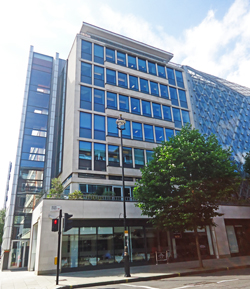
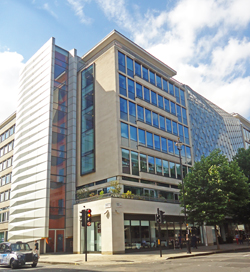
The site of the bomb-damaged building at No. 41 Baker Street is now occupied by a modern block which had once contained offices for Marks & Spencer plc.
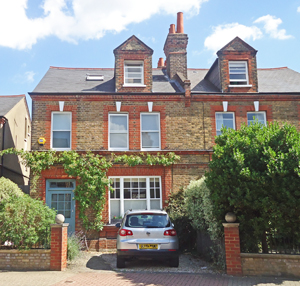
The short-lived Hospital at No. 63 Erpingham Road,Putney.
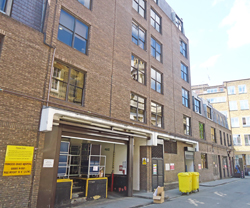
Oldbury Close constitutes the rear of the modern Princess Grace Hospital. Nos. 13 and 15 can be seen at the far end of the facade on the right of the image.
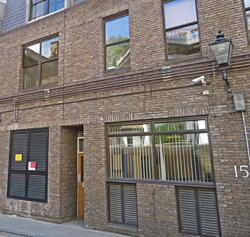
No. 13 Oldbury Place has been erased and its site is now incorporated into the Princess Grace Hospital.
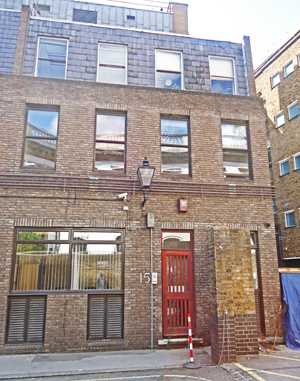
The Nature Cure Clinic building at No. 15 Oldbury Close has been taken over by the Princess Grace Hospital.
(Author unstated) 1979 Nature Cure Clinic's Golden Jubilee Year. The Vegan 26, 12.
Brown PS 1991 Medically qualified naturopaths and the General Medical Council. Medical History 35, 50-77.
McIntyre-Smith R 1976 The Nature Cure Clinic. The Vegan 23, 7-8.
Spencer C 1995 The Heretic's Feast - A history of Vegetarianism. Hanover and London, University Press of New England. p. 311.
http://icnm.org.uk (1)
http://icnm.org.uk (2)
http://idoxpa.westminster.gov.uk
http://sueyounghistories.com
www.all-creatures.org
www.ivu.org
Return to home page